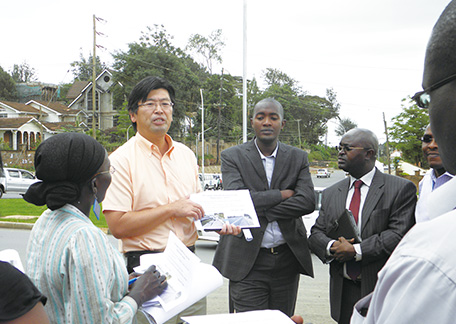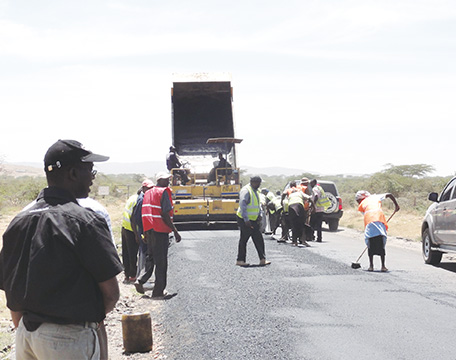Japan's Official Development Assistance White Paper 2013
Stories from the field 16
Save Kenya’s Roads, Arteries of the East African Economy!
– An Expressway Professional Creates a New Road Management Framework –

Local engineers (front) and Mr. Nishibayashi explain the importance of road maintenance to local media. (Photo: Motohiko Nishibayashi)
Located on Africa’s eastern seaboard, Kenya relies on its roads for about 95% of freight transportation. Its Mombasa Port, situated on the Indian Ocean, is likewise a crucial point for the trade of neighboring landlocked countries such as Uganda and Rwanda. Even so, the 14,000 km of trunk roads within the country are not being sufficiently maintained. Damage goes unrepaired, and there are areas of the road which remain unpaved. For these reasons, the improvement of Kenya’s roads has become a pressing issue for the economy of East Africa.
“People tend to talk about road building in developing economies, but roads are just like human bodies – just like how people need to get health checkups and vaccinations, if we don’t periodically conduct proper road maintenance, the roads will quickly fall into a state of disrepair and become unusable,” explained Mr. Motohiko Nishibayashi of Hanshin Expressway Co., Ltd. Over approximately 25 years, Mr. Nishibayashi has been widely involved in roads, from planning to maintenance, and for three years from July 2010, he was dispatched to Kenya as Chief Adviser to the “Strengthening of Capacity on Roads Maintenance Management through Contracting Project.”
In recent years, road management in Kenya has been undergoing reform. In 2009, public corporations were set up to handle day-to-day maintenance works, which are now basically entrusted to the private sector. The foundation has been laid for a road management system, but there are still issues to be dealt with in terms of the contracts for road work outsourcing and the supervision system. This project was initiated to establish frameworks suited to Kenya by making use of the road management methods and experience of Japan, which has already established similar systems to those that the country needs.
“My role is to find the weak points in the Kenyan system and shore them up. Since the moment I assumed this role I have been going around and listening to everyone involved in jobs related to these roads, from the Permanent Secretary of the Ministry of Roads to the officials in charge of the roads in each region. I have worked to understand the true needs here by listening to the people,” commented Mr. Nishibayashi. He explained how over the many months of his interviews, he felt firsthand the sophistication of the way people working with the roads in Kenya were thinking about them. They understood the issues facing road administration, and told Mr. Nishibayashi unanimously that they wanted to fix the nation’s roadways. Aware of each stakeholder’s wants as well as the current state of affairs and issues, Mr. Nishibayashi first implemented training in Japan before commencing work to draw new frameworks.
The training was designed to show participants the efforts going on behind the scenes in Japan in order to maintain the country’s roads – from cleaning work, the preparation of work equipment, methods of taking photographs for the record and the documents exchanged between contracting parties, to daily morning radio calisthenics. Mr. Nishibayashi said, “It was very simple training, but it resonated with the trainees. Many people told me that they wanted to implement similar frameworks in Kenya.” The training aims to go beyond just showing trainees the excellent roadway conditions and technology of Japan, to having them actually experience the daily management work needed for those roadways. Once the trainees understood that, it became easier for them to develop an image of the kinds of maintenance frameworks they wanted to build.
After returning to Kenya, the trainees joined the working group which started to work on the development of new frameworks for road maintenance. They created an estimation manual for the calculation of budgets and standard bidding prices related to maintenance, including grass cutting and cleaning work. They also conducted an objective check of the progress of contract work, evaluated completed work using a point-system, and constructed a system to share results among the road authorities. They introduced simple road inspection devices developed in Japan. And they drew up standard bidding guidelines for annual maintenance contracts. In doing so, they achieved reductions in the time and effort needed for the bidding process. In this way, a framework was set up to strengthen the cycle from the development of a budget for road maintenance to tendering, implementation, and evaluation, and this plan was applied to actual road maintenance work.
“The Kenyan side led the way on creating the bulk of these frameworks. It was because I don’t understand the details of the local customs or systems. Rather than making it perfect, we tried hard to just create a complete system. The trainees learned what we taught them well, and they applied that to their jobs. Because of that, we were able to make a framework that can really take root in Kenya.” By communicating not only the methods of road construction but also Japan’s knowledge about road maintenance, the project was able to satisfy the passionate hopes of the people of Kenya towards the safeguarding of the important road infrastructure that is supporting their economy.

Pavement resurfacing work takes place along a road through savanna. (Photo: Motohiko Nishibayashi)
